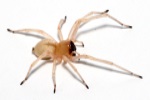Spider Control Toronto
Spiders Control Toronto
How to identify spiders
All spiders are arachnids, which means they have eight legs. Unlike insects, their body consists of only two parts, a cephalothorax and abdomen. Most spiders spin webs to catch their prey.
Black-Footed Spider (also called yellow sac spider)

- 4 to 9 mm long
- Pale yellow
- Black-tipped legs
Brown Recluse Spider

- 6 to 20 mm long
- Brown / tan
- Large mandibles
Wolf Spider

- Up to 3.5 cm long (body)
- Dark brown stripes
- Covered in short hair
Request A FREE Estimate
Where do spiders live?
There are about 1400 species of spiders in Canada. While all spiders are technically venomous, few Canadian species pose serious threats to humans. The most venomous spiders found in North America, such as the black widow, are relatively rare in Canada.
Spiders prefer to live in dark, moist environments, where they usually set up webs to catch insects. Most live in the wild or in parks and gardens, but they will sometimes invade buildings.
In the home, spiders prefer dark, undisturbed areas like attics, sheds, and basements. While most spiders don’t normally pose a health risk to humans, their presence can often be unsettling, especially for those with arachnophobia.
Spiders can thrive in areas with high insect populations, so their presence in your home could be associated with another type of infestation. Finally, spider webs are often associated with disrepair or neglect, so most people generally want to remove them from their homes.
How long do spiders live?
The average lifespan of a spider is about one to two years. Female spiders can lay anywhere from a few to a thousand eggs, and will protect them by encasing them in a silk cocoon.
She will then protect this egg sac until the eggs hatch, which is normally after about 2-3 weeks. The newly hatched spiders will stay close to their original nest for the first few weeks of their life until they set out to explore new territory.
What attracts spiders?
Spiders are attracted by the presence of insects and an abundance of dark, moist places to hide. Any space in a building which is either neglected or hard-to-reach by humans is a prime location for a spider to set up a web. Spiders are solitary creatures that are sensitive to disturbances.
Damp areas such as basements are prime locations for encountering spiders. They can also be found near plumbing and drains. Any dark space with a lot of clutter that doesn’t get moved around frequently provides an abundance of areas for them to hide.
How to prevent spiders from invading your home
Spiders gain entry into buildings through cracks, crevices and openings in doors, windows and moldings. Ensuring your building is properly maintained and sealing all entryways will go a long way in preventing spiders from gaining access to your space.
Spiders only feed on insects, so keeping your home clean and free of bugs will also discourage spiders from setting up shop.
Finally, controlling moisture is key to avoiding spider infestations. Keep your space dry and well-ventilated – use dehumidifiers if necessary.
What to do if you have spiders
The fist step in dealing with a spider infestation in your home is to determine which species of spider you have. Some spiders might pose more of a threat than others, and their extermination needs to be approached with proper care.
In general, keeping your home dry using ventilation and de-humidifiers will reduce the likelihood of spiders staying in your space. Ensuring that your home is relatively insect-free will also help curb spider populations.
If you’re not sure which spider species is infesting your home, or if you are not prepared to deal with spiders in any way yourself, call a spider control professional. We’ll accurately identify which species in present and take proper steps to ensure they are thoroughly removed from your property.
Get a Free Quote
AREAS WE SERVE:
We offer professional spider control and wildlife removal services in Toronto and surrounding areas. If you are having some problems with pests or wildlife give us a call and we will provide a quick free quote or fill out our form.
– Ajax
– Aurora
– Brampton
– Burlington
– Bolton
– Etobicoke
– Kleinburg
– King City
– Pickering
– Markham
– Milton
– Mississauga
– Oakville
– Oshawa
– Richmond Hill
– Scarborough
– Stouffville
– Toronto
– Vaughan
– Whitby